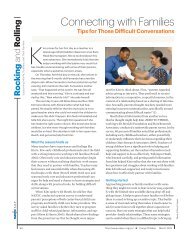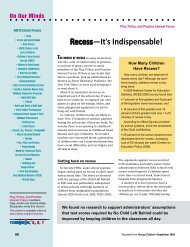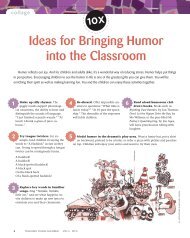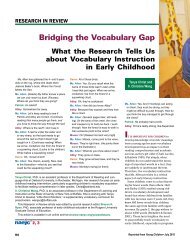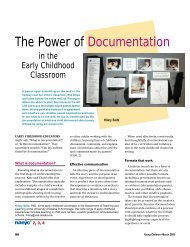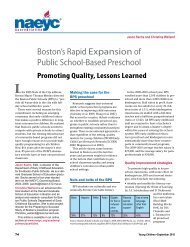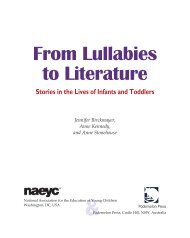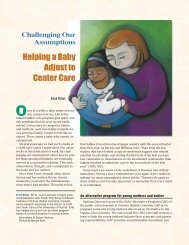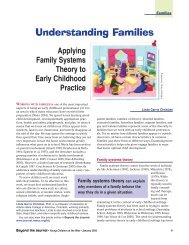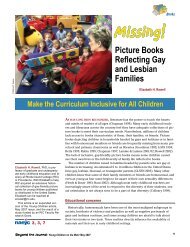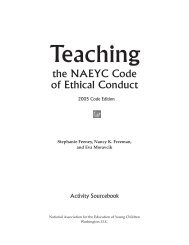Observation and Early Childhood Teaching - National Association ...
Observation and Early Childhood Teaching - National Association ...
Observation and Early Childhood Teaching - National Association ...
Create successful ePaper yourself
Turn your PDF publications into a flip-book with our unique Google optimized e-Paper software.
Our Proud<br />
Our Proud<br />
Her tage<br />
Charlotte Anderson <strong>and</strong> Edna Ranck<br />
<strong>Observation</strong><br />
<strong>and</strong><br />
<strong>Early</strong><br />
<strong>Childhood</strong><br />
<strong>Teaching</strong><br />
Evolving<br />
Fundamentals<br />
Stuart Reifel<br />
Let them observe, lead their<br />
pupils to observe, <strong>and</strong> render<br />
themselves <strong>and</strong> their pupils<br />
conscious of their observations.<br />
— Friedrich Froebel<br />
© Karen Phillips<br />
<strong>Observation</strong> of children has a long<br />
history in early childhood teaching.<br />
<strong>Early</strong> nineteenth-century German<br />
educator Friedrich Froebel (1782–<br />
1852) wanted kindergarten teachers<br />
to be observers of children (Froebel<br />
[1826] 1902) so they could learn how<br />
children think <strong>and</strong> learn, build on<br />
their interests, <strong>and</strong> underst<strong>and</strong> the<br />
importance of their play to growth<br />
<strong>and</strong> development. He believed that<br />
children learn to solve problems <strong>and</strong><br />
think about life, science, <strong>and</strong> art as<br />
they manipulate objects <strong>and</strong> observe<br />
the results of their actions. Teachers<br />
were also seen as learners, about their<br />
students: they needed to observe<br />
to underst<strong>and</strong> how children were<br />
developing.<br />
To this day there is a continuous<br />
emphasis on classroom observation of<br />
young children in education texts <strong>and</strong><br />
professional preparation. To underst<strong>and</strong><br />
each developmentally unique<br />
child (compared to other children)<br />
requires teachers to use observation<br />
<strong>and</strong> interpretation skills. St<strong>and</strong>ardized<br />
school assessments fail to provide<br />
this kind of information about children.<br />
In the past decade of No Child<br />
Left Behind <strong>and</strong> Race to the Top, with<br />
US society placing more emphasis<br />
on testing <strong>and</strong> academic curriculum,<br />
many teachers are expected to give<br />
more attention to children’s written<br />
work than to things that teachers can<br />
actually see children do. It is worth<br />
our while to reconsider the importance<br />
of teacher observation <strong>and</strong> how<br />
our thinking about observation has<br />
evolved over the years.<br />
Stuart Reifel, EdD, is professor of early childhood education at the University of<br />
Texas at Austin. He teaches undergraduate courses on childhood play <strong>and</strong> curriculum<br />
<strong>and</strong> works with graduate students on research related to play, teaching,<br />
From the past to the present<br />
<strong>and</strong> curriculum. Stuart’s major focus is play theory <strong>and</strong> practice.<br />
Our Proud Heritage is published in the March, July, <strong>and</strong> November issues<br />
of Young Children <strong>and</strong> features contributing writers who offer insights on past<br />
Young Children practice, • January knowledge, 2009 <strong>and</strong> leadership in early childhood education. For submission<br />
When Froebel encouraged teachers<br />
to observe <strong>and</strong> make themselves conscious<br />
of their 3observations,<br />
he had<br />
guidelines, go to www.naeyc.org/yc/columns/ourproudheritage or contact one<br />
in mind something very different from<br />
of the coeditors: Edna Runnels Ranck at edna.ranck@verizon.net, or Charlotte how we think about observation in the<br />
Anderson at charli@charlottephd.com.<br />
twenty-first century. Teachers then<br />
This column is available in an online archive at www.naeyc.org/yc/columns. were to think about how children with<br />
Froebel’s gifts <strong>and</strong> occupations were<br />
62 Reprinted from Young Children • March 2011
playing their way to an underst<strong>and</strong>ing<br />
of nature, beauty, <strong>and</strong> divine unity.<br />
Froebel wanted teachers to see<br />
how children developed as they<br />
manipulated specific objects (gifts<br />
<strong>and</strong> occupations he designed for<br />
their education), such as blocks<br />
for design construction, parquetry<br />
shapes for picture creation, paper<br />
strips for weaving, <strong>and</strong> drawing forms<br />
(Brosterman 1997).<br />
Teachers knew what to look for as<br />
the child manipulated these objects<br />
from simpler forms (such as stacked<br />
block piles) to more complicated<br />
configurations (such as symmetrical<br />
configurations of blocks that resembled<br />
flowers). They used their observations<br />
to nurture children toward the<br />
next developmental object manipulation,<br />
assuming that children were<br />
acquiring the knowledge that Froebel<br />
built into his play objects. Today’s<br />
teachers have a broader range of<br />
© Shari Schmidt<br />
developmental <strong>and</strong> learning concerns<br />
than those identified by Froebel.<br />
The Child Study Movement.<br />
Through his Child Study Movement,<br />
G. Stanley Hall (1844–1924) <strong>and</strong> the<br />
many graduate students who followed<br />
him asked teachers to observe <strong>and</strong><br />
interview children to underst<strong>and</strong> their<br />
developmental stages <strong>and</strong> ultimate<br />
readiness for school learning. Using<br />
direct observation <strong>and</strong> systematic verbal<br />
interviews with children, teachers<br />
could learn about children’s interests<br />
<strong>and</strong> thinking.<br />
Hall’s recapitulation theory<br />
described how children re-create the<br />
evolutionary history of our species.<br />
Through play they outgrow their<br />
“primitive” origins on the way to<br />
the civilizing benefits of education.<br />
<strong>Observation</strong> allowed teachers to recognize<br />
the signs that children were still<br />
playing in ways that made them too<br />
immature to benefit from academics.<br />
Research into practice. Hall <strong>and</strong><br />
many who followed him wanted scientific<br />
research to serve as a basis for<br />
teachers to think about children’s education,<br />
including the physical, social,<br />
emotional, <strong>and</strong> intellectual aspects of<br />
human development.<br />
John Dewey (1859–1952) encouraged<br />
educators to see the seeds of<br />
democratic social relationships in<br />
the classroom play of young children.<br />
Arthur Jersild (1902 –1994) wanted<br />
teachers to observe <strong>and</strong> have conversations<br />
with children to underst<strong>and</strong><br />
more about their interests, as<br />
well as their motor, language, social,<br />
emotional, cognitive, <strong>and</strong> imaginative<br />
learning. Lev Vygotsky (1896–1934)<br />
<strong>and</strong> Jean Piaget (1896 –1980) focused<br />
on their theories of what we know<br />
about children’s thinking; they also<br />
showed us how to observe the ways<br />
children make sense of their worlds.<br />
For nearly two centuries, researchers<br />
used their observations <strong>and</strong> conversations<br />
with children to identify<br />
new aspects of how children behave in<br />
classroom activity <strong>and</strong>, perhaps more<br />
Why <strong>Observation</strong>?<br />
How Teachers Benefit<br />
To build relationships with<br />
children<br />
• Get to know each child<br />
• Respect <strong>and</strong> appreciate children<br />
• Connect with children<br />
• Foster children’s competence <strong>and</strong><br />
success<br />
To become a skilled observer<br />
• What do I want to find out?<br />
• When <strong>and</strong> where should I observe?<br />
• How do I record what I observe?<br />
• How do I organize the information<br />
I collect?<br />
To observe <strong>and</strong> document<br />
effectively<br />
• Observe over time<br />
• Watch children in varied situations<br />
• Record what you observe<br />
• Organize the information you<br />
collect<br />
Adapted from J.R. Jablon, A.L. Dombro,<br />
<strong>and</strong> M.L. Dichtelmiller, The Power of<br />
<strong>Observation</strong> from Birth through Eight, 2nd<br />
ed. (Washington, DC: <strong>Teaching</strong> Strategies<br />
& NAEYC, 2007), iii. © The authors. Used<br />
with permission.<br />
important, to provide new ways educators<br />
could reflect on or become conscious<br />
of what those activities mean<br />
for children’s education. Interestingly,<br />
while play is defined differently<br />
throughout the changing eras, it continues<br />
to be a major focus of observation<br />
(Frost, Wortham, & Reifel 2008).<br />
Teacher preparation. In the late<br />
nineteenth <strong>and</strong> early twentieth centuries,<br />
textbooks for teachers of young<br />
children were prescriptive, explaining<br />
how to get children to march<br />
to music <strong>and</strong> how to lead counting<br />
drills. Frequent descriptions of children’s<br />
activities reflected teachers’<br />
use of observation (for examples, see<br />
McMillan 1921).<br />
Reprinted from Young Children • March 2011 63
With increased research on social<br />
relationships, emotional needs, <strong>and</strong><br />
children’s interests for teachers<br />
to draw on, early childhood texts<br />
began to explicitly call on teachers<br />
to observe <strong>and</strong> interview children so<br />
they could begin to nurture all dimensions<br />
of the “whole” child. Suggestions<br />
of what to look for when observing<br />
varied, depending on the findings<br />
of new research about children.<br />
Teachers might look for motor, social,<br />
<strong>and</strong> emotional skills <strong>and</strong> underst<strong>and</strong>ings<br />
about aesthetics <strong>and</strong> nature <strong>and</strong><br />
the physical world (for examples, see<br />
L<strong>and</strong>reth 1942). They could observe<br />
children as scientists, mathematicians,<br />
<strong>and</strong> players (Gans, Stendler,<br />
& Almy 1952) or see how children<br />
socially adjust <strong>and</strong> deal with feelings<br />
(for examples, see Read 1960).<br />
<strong>Observation</strong> as a new asset<br />
Eventually, observation itself<br />
became an explicit topic in texts,<br />
including how teachers might use<br />
informal notes <strong>and</strong> keep running<br />
records on each child (Read &<br />
Patterson 1980) <strong>and</strong> develop different<br />
data collection techniques for<br />
recording individual, group, <strong>and</strong><br />
student progress (Almy & Genishi<br />
1979). Vivian Paley (2004) illustrates<br />
the contributive value of observation<br />
<strong>and</strong> other documentation of children<br />
for the teacher. Jablon, Dombro, <strong>and</strong><br />
Dichtelmiller (2007) further cement<br />
the power of observation.<br />
Whether providing explicit guidance<br />
for teachers about how to observe or<br />
suggesting specific aspects of children’s<br />
behavior to observe <strong>and</strong> interpret,<br />
all of these resources appear to<br />
help teachers underst<strong>and</strong> more about<br />
the children they teach. Some authors<br />
(for example, Paley 2004) provide<br />
wonderfully rich descriptions of children<br />
<strong>and</strong>, by example, demonstrate<br />
the power of observation for improving<br />
classroom practice.<br />
Increasingly, new research focuses<br />
as much on teacher consciousness<br />
or awareness as on the play teachers<br />
are to observe. Sherwood <strong>and</strong><br />
Reifel (2010) report their findings that<br />
today’s preservice teachers bring with<br />
them beliefs <strong>and</strong> underst<strong>and</strong>ings that<br />
influence how they see children’s play.<br />
Reflective teaching. <strong>Observation</strong><br />
is necessary for teachers’ underst<strong>and</strong>ing<br />
of children, but developing the<br />
skills to think about what teachers<br />
observe <strong>and</strong> to integrate their reflections<br />
in their teaching are what lead to<br />
the planning that supports children’s<br />
learning. Teachers then begin to see<br />
all the aspects of development <strong>and</strong><br />
learning that researchers tell us are<br />
there to be seen.<br />
There are many conceptual lenses<br />
to help us all underst<strong>and</strong> children.<br />
The need is to learn which lens to<br />
use when we watch what children do<br />
(Frost, Wortham & Reifel 2008). When<br />
we look at group play, do we see only<br />
the formation of social relationships,<br />
or do we also consider how children’s<br />
play reflects their growing underst<strong>and</strong>ing<br />
of events in the real world?<br />
When we watch children build with<br />
blocks, do we see only construction<br />
<strong>and</strong> collaboration, or do we also look<br />
for evidence of spatial thinking in the<br />
construction <strong>and</strong> the story narrative<br />
the children are thinking about as<br />
they build?<br />
<strong>Observation</strong> as a part of documentation.<br />
An observation can lead to<br />
many underst<strong>and</strong>ings about children,<br />
all of which merit documentation <strong>and</strong><br />
reflection (see Carter & Curtis 2011).<br />
What we see can help us plan further<br />
lessons about world events, spatial<br />
thinking, narrative development, <strong>and</strong><br />
many other worthy topics that children<br />
are ready to explore.<br />
Looking to the future<br />
Educators no longer watch children<br />
for signs of Froebel’s version of play<br />
nor do they look for Hall’s play stages.<br />
But we do want to see how children<br />
are developing <strong>and</strong> learning, whether<br />
they are solving social problems, in-<br />
ternalizing self-control, or making<br />
64 Reprinted from Young Children • March 2011<br />
© Karen Phillips
sense of classification (Copple &<br />
Bredekamp 2009).<br />
Building on a long heritage of<br />
observation, teachers will discover<br />
new things to see <strong>and</strong> new ways to<br />
underst<strong>and</strong> children. With these<br />
in mind, they can know more, for<br />
example, about children’s friendships,<br />
their depth of thinking (especially<br />
when children cannot say all that<br />
they know), the social influences on<br />
classroom learning, how children are<br />
constructing their gender notions of<br />
what it means to be a girl or a boy,<br />
<strong>and</strong> what motivates children to do<br />
what they do.<br />
All of children’s classroom play<br />
requires sensitive observation <strong>and</strong><br />
constant reflection to see how play<br />
contributes to children in the present<br />
<strong>and</strong> over time. These are aspects of<br />
children’s performance that can transcend<br />
what tests help us to know, <strong>and</strong><br />
they all build on observation.<br />
References<br />
Almy, M., & C. Genishi. 1979. Ways of Studying<br />
Children. Rev. ed. New York: Teachers College<br />
Press.<br />
Brosterman, N. 1997. Inventing Kindergarten.<br />
New York: Harry N. Abrams.<br />
Copple, C., & S. Bredekamp, eds. 2009. Developmentally<br />
Appropriate Practice in <strong>Early</strong> <strong>Childhood</strong><br />
Programs Serving Children from Birth<br />
through Age 8. 3rd ed. Washington, DC: NAEYC.<br />
Curtis, D., & M. Carter. 2011. Reflecting Children’s<br />
Lives: A H<strong>and</strong>book for Planning Your<br />
Child-Centered Curriculum. 2nd ed. St. Paul,<br />
MN: Redleaf.<br />
Froebel, F. [1826] 1902. Education of Man. Trans.<br />
by W.N. Hailmann. New York: Appleton.<br />
Frost, J.F., S. Wortham, & S. Reifel. 2008. Play<br />
<strong>and</strong> Child Development. 3rd. ed. Upper<br />
Saddle River, NJ: Prentice Hall/Merrill.<br />
Gans, R., C.B. Stendler, & M. Almy. 1952. <strong>Teaching</strong><br />
Young Children in Nursery School, Kindergarten,<br />
<strong>and</strong> the Primary Grades. New York:<br />
World Books.<br />
Jablon, J.R., A.L. Dombro, & M.L. Dichtel-<br />
miller. 2007. The Power of <strong>Observation</strong> for<br />
Birth through Eight. 2nd ed. Washington, DC:<br />
<strong>Teaching</strong> Strategies & NAEYC.<br />
L<strong>and</strong>reth, C. 1942. Education of the Young<br />
Child: A Nursery School Manual. New York:<br />
John Wiley & Sons.<br />
Increasing teacher effectiveness!<br />
The Intentional Teacher<br />
Choosing the Best Strategies for<br />
Young Children’s Learning<br />
by Ann S. Epstein<br />
This best-selling book is an invaluable resource for classroom educators.<br />
Explore how to use child-guided <strong>and</strong> teacher-guided experiences, alone<br />
<strong>and</strong> in combination, to strengthen children’s learning.<br />
Item #165 • ISBN: 978-1-928896-41-8 • 2007 • 148 pp • Softcover<br />
• Members: $16.00 20% savings • List: $20.00<br />
McMillan, M. 1921. The Nursery School. London:<br />
J.M. Dent & Sons.<br />
Paley, V.G. 2004. A Child’s Work: The Importance<br />
of Fantasy Play. Chicago: University of<br />
Chicago Press.<br />
Read, K. 1960. The Nursery School: A Human<br />
Relationships Laboratory. 3rd ed. Philadelphia:<br />
Saunders.<br />
Read, K., & J. Patterson. 1980. The Nursery<br />
School <strong>and</strong> Kindergarten: Human Relationships<br />
<strong>and</strong> Learning. 7th ed. New York: Holt,<br />
Rinehart, & Winston.<br />
Sherwood, S., & S. Reifel. 2010. “The Multiple<br />
Meanings of Play: Exploring Preservice<br />
Teachers’ Beliefs about a Central Element of<br />
<strong>Early</strong> <strong>Childhood</strong> Education.” Journal of <strong>Early</strong><br />
<strong>Childhood</strong> Teacher Education 31: 322–43.<br />
Additional resource<br />
Jablon, J. 2010/2011. “Taking It All In: <strong>Observation</strong><br />
in the Classroom.” <strong>Teaching</strong> Young<br />
Children 4 (2): 24–27.<br />
Copyright © 2011 by the <strong>National</strong> <strong>Association</strong> for the<br />
Education of Young Children. See Permissions <strong>and</strong><br />
Reprints online at www.naeyc.org/yc/permissions.<br />
Order online: www.naeyc.org/store • Or call: 800-424-2460<br />
Reprinted from Young Children • March 2011 65





